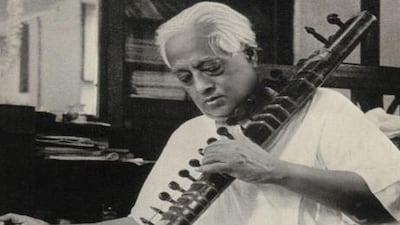NEW DELHI // The Higgs boson may be named after Peter Higgs, but it also owes part of its nomenclature to another scientist: Satyendra Nath Bose, an Indian physicist pulled out of obscurity by Albert Einstein.
Bose died in 1974, but his early work on quantum statistics was so influential that the class of particles called bosons was named after him, even though he did not work directly in particle physics.
His most well-known paper, published in the journal Zeitschrift für Physik in 1924, was translated from English into German by Einstein. It yielded such important results that the Indian physicist Jayant Narlikar, in his 2003 book The Scientific Edge, called it "one of the top ten achievements of 20th century Indian science … [to] be considered in the Nobel Prize class".
Born in Kolkata (then Calcutta) in 1894, Bose joined the University of Calcutta as a lecturer in 1916, where he worked with another Indian physicist, Meghnad Saha, to translate Einstein's relativity papers into English. He then moved to the physics department of the University of Dhaka in 1921.
"There is a perception that Bose was a statistician, but he was actually a physics teacher. His inclination was towards mathematical physics," said CS Unnikrishnan, a professor at the Mumbai-based Tata Institute of Fundamental Research, who has worked on a state of matter called the Bose-Einstein Condensate.
"In his famous paper, he described how a bunch of particles distribute themselves, which is where the statistics comes in," Mr Unnikrishnan said.
The paper, written in the early 1920s, worked to resolve a contradiction in physics at the time. Max Planck, a German physicist, had won the Nobel Prize in 1918 for describing how objects emitted radiation such as light in discrete packets of energy called quanta.
To do this, Mr Unnikrishnan said, Planck had considered light first as a wave and then as a particle. "Somehow, it appeared as cheating in physics - that was Bose's impression." Bose's paper treated light as a "gas" of light particles, and he worked out a technique to chart the distribution of these particles such that Planck's equation still held good.
When the paper was rejected by a journal called Philosophical Magazine, he sent it to Einstein, addressing him as "Respectful Master".
"I do not know sufficient German to translate the paper," Bose wrote to Einstein in his letter. "If you think the paper worth publication I shall be grateful if you arrange for its publication in Zeitschrift für Physic (sic). Though a complete stranger to you, I do not feel any hesitation in making such a request [because] we are all your pupils, though profiting only by your teachings through your writings."
Einstein, in his translator's note, called "Bose's derivative of Planck's formula … an important step forward".
He would also apply Bose's technique to atoms of ordinary gases - discovering, in the process, the low-energy state of supercooled atoms in Bose-Einstein Condensates.
"I had no idea that what I had done was really novel," Bose would once tell Jagdish Mehra, who wrote a short biography of him for the Royal Society in 1975.
"I was not a statistician to the extent of really knowing that I was doing something different."
At Einstein's invitation, Bose travelled to Europe for two years, to meet the leading physicists of his time. But nothing came of these collaborations.
In a 1972 article in the American Journal of Physics, the physicist William Blanpied suggested that "the young Bose was terribly intimidated by most Europeans".
After his return to India, Bose continued to write papers and send them to Einstein.
"But Einstein was not so impressed by any of the later things," Mr Unnikrishnan said. "He didn't even reply to a few of them. He was not very encouraging."
Bose's career in India continued to blossom, however. He became the president of the Indian Science Congress and of the Indian Physical Society.
He was nominated to the upper house of India's parliament, served as a scientific adviser to the government of India, and made forays into biotechnology, chemistry and anthropology.
He was also known as a polyglot and as a skilled musician on the flute and the esraj.
Although Bose never won a Nobel, work on Bose-Einstein Statistics and Bose-Einstein Condensates have won several other physicists Nobel Prizes.
"There can be no doubt that Bose's is the most original and useful of all scientific ideas from modern India," the physicist Partha Ghose wrote in a column in Kolkota's The Telegraph in January.
Meanwhile, the particles called bosons, which obey Bose's statistical distributions, continue to puzzle physicists, Mr Unnikrishnan said. "We have found that the property of being a boson depends on how much spin each particle has, but there is no physical understanding yet as to why this is so," he said.
"Even now, we continue to work to understand that."

